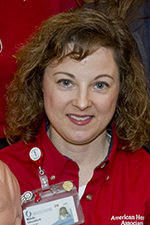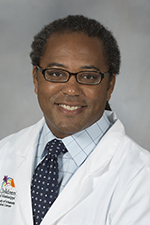Don’t delay: Do CPR right away!

Published on June 27, 2017
Too often, well-meaning bystanders call 911 to get help for someone who's not breathing - and then they stand by while waiting for emergency responders to arrive.
Instead, someone should immediately begin cardiopulmonary resuscitation, or CPR, on the unresponsive person and continue without stopping until a medical crew takes over.

Schweinfurth
Everyone should give a swift three-pronged response when faced with that scenario, said Dr. Michelle Schweinfurth, director of the Basic and Advanced Resuscitation Training Center at the University of Mississippi Medical Center.
“Call 911, push hard, and push fast,” Schweinfurth said.
And for those who are hesitant to begin the resuscitation step of mouth-to-mouth breathing, it's OK, according to Schweinfurth.
“Blowing air in a person's lungs is not the priority,” she said. “That's not what is going to restart a person's heart. You're filling the lungs with air, and it's going nowhere.”
As summer swimming and outdoor fun take off, it's critical that people know not to wait for help before starting CPR. It gives an unresponsive person - for example, a near-drowning victim or someone whose heart has stopped - blood flow to their organs, allowing them the best chance of surviving until first responders arrive.
Every delayed minute of CPR can mean devastating loss of brain function, not just life. The chance to avert brain damage caused by lack of oxygen is just one more reason why any bystander needs to be able to give good, uninterrupted CPR.
“Unfortunately, a lot of these events happen out in the community,” said Dr. Michael Holder, associate professor of pediatrics and emergency medicine and executive director of the Office of Interprofessional Simulation Training Assessment Research and Safety at UMMC.
“You really depend on your neighbor or friend or family member to intervene and start CPR, but a lot of people will stand around while they're getting in touch with 911,” he said. “People need to realize they can start chest compressions before that.”
Members of the public who in good faith and with reasonable care begin the resuscitation process until trained emergency responders arrive are exempted from liability by the state's Good Samaritan Law, Schweinfurth said.

Holder
According to Holder and Schweinfurth, the process isn't hard, and both lay people and trained health care providers can make a difference. The important thing is to not hesitate to use resuscitation if a person is no longer breathing, which generally means they also no longer have a pulse.
Place one hand on top of the other “in the center of the chest and push hard - for adults, at least two inches down,” Schweinfurth said. “The technicalities aren't important. Don't be afraid of hurting the person. Push hard and push fast at a rate of at least 100 compressions per minute.”
She advises to try keeping the compressions in a rhythm.
“Some people sing 'Staying Alive' to keep the beat,” she said of the 1977 disco hit by the BeeGees. The American Heart Association wrapped a video around the memorable song to drive home the message with humor from comedian Ken Jeong.
"Compressions start to feed the vital organs, including the heart, with blood and oxygen,” Holder said. “Even though you might not be breathing, you can have oxygen in your blood.”
A handheld automated external defibrillator, a portable device that checks the heart rhythm and can send an electric shock to the heart to try to restore its normal rhythm, can be used to treat sudden cardiac arrest. That's when the heart unexpectedly stops beating. The AED automatically diagnoses the heart's rhythm, making the decision whether or not the person needs a shock.
Holder found himself on the giving end of CPR and an AED in April 2016 when a Madison County man's heart stopped beating as he was finishing a bicycle ride in Ridgeland. Holder was dining with a number of pediatric emergency medicine physicians and nurses in a nearby restaurant when one of David Lindsey's fellow riders burst in, clamoring for help.
Holder jumped into the bed of a truck where the bicyclist had passed out, giving him chest compressions with the help of his coworkers until medics arrived. Holder and his team administered a defibrillator shock with the AED carried on the medics' vehicle. Then Holder rode in the ambulance with Lindsey, continuing his care until their arrival at UMMC.
It's becoming more common to find life-saving AEDs in public places, such as malls, gyms, churches, schools or other areas where people congregate. Even so, people should think CPR first, said Dr. Alan Jones, professor and chair of the Department of Emergency Medicine at UMMC.
“Bystander CPR is recommended prior to AED placement if there will be a delay,” Jones said. “In general, CPR prior to AED placement is recommended when a trained individual can administer the CPR.”
“You need to start CPR,” Holder said. “By the time a person figures out what they need to do, or get the AED, you could have lost precious time. When the AED arrives, you still have to open the person's shirt, remove clothing . . . All those things take time.
“You need to be doing chest compression while you are setting it all up.”
“An AED might look scary to people who have never used one, but they are very foolproof little computers,” Schweinfurth said. “It will walk you through, step by step, how to use it.”
The Medical Center offers both basic and advanced CPR and AED training. Its “Heart Saver CPR/AED” class targets members of the community who aren't health care providers. Attendees learn appropriate resuscitation treatment for infants through adults.
“When someone is at the point where they need CPR, the compressions are crucial in order to get them to the next stage of resuscitation,” Holder said. “You can't have advanced resuscitation without basic resuscitation - even if you're administering it in the hospital.”
Holder and Schweinfurth agree that when an emergency arises, don't forget what needs to happen in tandem with compressions: Call 911, or have another bystander dial the number.
“If you're completely by yourself, the America Heart Association says take your phone, dial 911 and put it on speaker,” Schweinfurth said. “You can keep making compressions before the line even answers.”
CPR Tip Sheet
CPR is easy to learn, and even the most basic training can save lives in an emergency. If you'd like to be trained, consult the class schedule on UMMC Training Center's website.
Here's what the experts recommend:
If a person passes out and becomes unresponsive, check to see if he's breathing. If not, call 911 and begin CPR.
For an adult or child older than 1, place one of your hands on top of the other and do steady compressions, about two inches deep, at a rate of 100-120 per minute. For infants younger than 1, use two fingers and push at the same rate, but only about an inch and a half deep.
Continue CPR until emergency responders arrive. If needed, take turns doing compressions with another bystander.
If following CPR with an AED, don't stop CPR until the machine is in use. Each unit is programmed to lead the user through the proper steps, including whether or not an electric shock is warranted.


